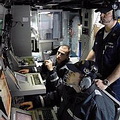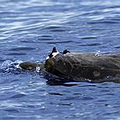 美國最高法院(U.S. Supreme Court)10月8日夾在美國軍方及環保人士的爭議之間,對於聯邦法官是否有權力強制海軍在加州海岸外圍管制聲納演練,看法相當分歧。管制演練是要將聲納對鯨類及海豚的傷害降至最低。
美國最高法院(U.S. Supreme Court)10月8日夾在美國軍方及環保人士的爭議之間,對於聯邦法官是否有權力強制海軍在加州海岸外圍管制聲納演練,看法相當分歧。管制演練是要將聲納對鯨類及海豚的傷害降至最低。
這個受到高度關注的案子碰觸到總統權力中沒有明確定義的議題,也碰觸到軍方遵循關鍵環境法律的義務,這些法律要求聯邦部門要考慮並減少他們執行業務時對環境的衝擊。
這個爭議是起源於美國海軍計畫從2007年1月開始,要以他們在加州海岸外圍的中頻主動聲納(mid-frequency active sonar)進行一系列共計14項的潛水艇搜索演練。
有證據顯示,這種聲納會傷害鯨類及海豚,干擾他們的通訊及導航能力,並且有可能會導致他們因擱淺而死亡。
自然資源保護委員會(Natural Resources Defense Council,NRDC)及另外5個環境團體在2007年3月提出告訴,宣稱海軍違反聯邦環境法律,並未妥善地評估他們的行動對海洋哺乳動物的潛在衝擊。
 在加州的法庭上,美國聯邦地方法院法官庫波(Florence- Marie Cooper)認同許多這些團體的主張。她發出一份初步的禁制令,命令海軍要限制他們執行聲納測試業務的權力與區域,以保護海洋哺乳動物。
在加州的法庭上,美國聯邦地方法院法官庫波(Florence- Marie Cooper)認同許多這些團體的主張。她發出一份初步的禁制令,命令海軍要限制他們執行聲納測試業務的權力與區域,以保護海洋哺乳動物。
於是布希政府採取行動豁免海軍對相關環境法律的義務,宣稱聲納演習對國家安全是必要的。但是第九巡迴上訴法庭(the Ninth Circuit Court of Appeals)表示支持地方法院的裁定,促使布希政府向最高法院提出上訴。
美國聯邦檢察總長(U.S. Solicitor General)蓋瑞(Gregory Garre)敦促最高法院撤銷低等法院的裁定,表示這個聲納測試「對我們國家的安全是具關鍵性的」。但是蓋瑞已面對最高法院4位自由派法官與首席法官羅伯茲(John Roberts)一連串提問的猛烈攻擊,這些提問主要針對海軍決定不在演習開始執行之前準備環境影響說明書(environmental impact statement,EIS)。
蓋瑞解釋說,海軍的演習環境評估顯示這項演習對鯨類及海豚的影響很小,因此才沒有完成環境影響說明書。蓋瑞表示,美國海軍在加州海岸外圍使用中頻主動聲納「已超過40年,而沒有任何人可以證明這對海洋哺乳動物有任何傷害」。他的聲明卻沒有獲得法官史蒂芬斯(Justice John Paul Stevens)的親睞,他表示僅是缺少環境影響說明書就足以讓高等法院阻擋演習的執行,在這項文件中必須敘明降低環境衝擊的替代方案與策略。
The U.S. Supreme Court today waded into a dispute between the U.S. military and environmentalists and appeared closely divided over whether a federal judge had the authority to force the Navy to restrict sonar training exercises off the coast of California in order to minimize harm to whales and dolphins.
The closely watched case touches on controversial issues of presidential power and the military's obligation to follow key environmental laws that require federal agencies to consider and mitigate the environmental impacts of their activities.
The dispute emerged from the Navy's plan to conduct a series of 14 submarine hunting exercises using its mid-frequency active sonar off the coast of California, beginning in January 2007.
The sonar has been found to injure whales and dolphins, interfering with their ability to communicate and navigate and potentially causing fatal strandings.
The Natural Resources Defense Council and five other environmental groups filed suit in March 2007, alleging the Navy had failed to properly assess the potential impact to marine mammals in violation of federal environmental laws.
In a California courtroom, U.S. District Judge Florence-Marie Cooper agreed with many of the groups' claims. She issued a preliminary injunction, ordering the Navy to restrict the power and location of its sonar testing to protect marine mammals.
The Bush administration then moved to exempt the Navy from the relevant environmental laws by declaring the sonar training exercises essential to national security.
But the Ninth Circuit Court of Appeals upheld the district court ruling, prompting the Bush administration's appeal to the Supreme Court.
U.S. Solicitor General Gregory Garre urged the court to vacate the lower court ruling, calling the sonar testing "critical to the nation's own security."
But Garre faced a barrage of questions from the court's four liberal justices and Chief Justice John Roberts about the Navy's decision not to prepare an environmental impact statement, EIS, before it began the training exercises.
Garre explained that the Navy's environmental assessment of the training exercises indicated little harm to whales and dolphins and so precluded the completion of an EIS.
The Navy has been using mid-frequency active sonar off the coast of California "for more than 40 years and no one can point to any harm to marine mammals," Garre said.
That failed to appease Justice John Paul Stevens, who said it made sense for courts to block or restrict the training exercises in the absence of an EIS, a document that outlines alternatives and strategies to mitigate environmental impacts.
全文及圖片詳見:ENS






